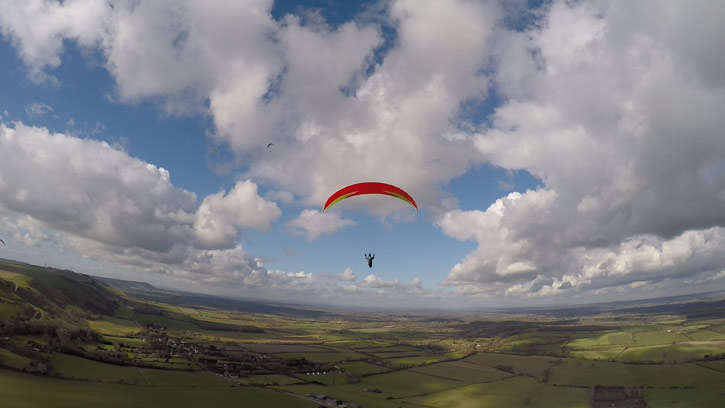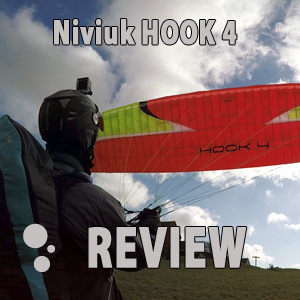
With the recent introduction of the Ikuma in Niviuk's range at the high end of the EN B class (what we call XC class) it seems that the new Hook has been redesigned to be a simpler, calmer wing at the low end of the EN B class (what we call a Progression class), to meet the needs of recent graduates or low-airtime pilots. As such the Hook 4 loses some of the 'hook' turn of its predecessors and offers a milder ride while retaining good performance and high passive safety.
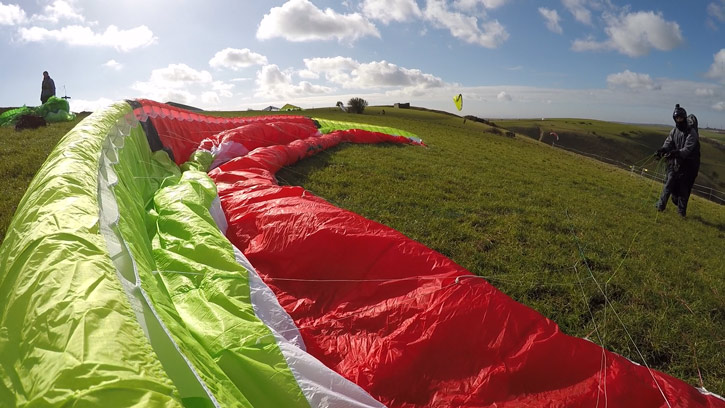
The leading edge stands ready to gulp down some spring air
The risers are standard, fairly wide webbing, and a simple line plan that has 3 As, 2Bs and a stabilo, and 2Cs - fairly minimalist for the class, but the split As yield small 'big ears' that won't alarm newbies, and the Cs allow the wing to be effectively pinned down in strong wind conditions, especially when the brakes lines are gathered at the same time.
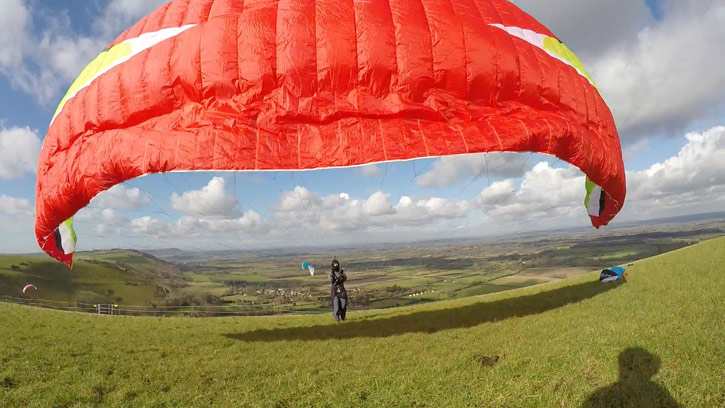
The front section of the wing inflates first, the spanwise kink slows the acceleration
Launching the Hook 4 is a simple matter - pull on the As until it's mostly overhead. Even in strong wind, this resulted in no shooting acceleration and the wing stopped on its own, so there's no risk of unexpected launches. This meets the needs of the target pilot group very well. However, the downside is that the wing can be rather lazy at times, if you release the As too early, or have a fickle crosswind or tangled tip. The wing likes to drop back from about 50 degrees, and won't recover without being re-energised on the As. Although the solution is available - simply hang on the As - I prefer a wing in this class to help the pilots a bit more on getting into the air.
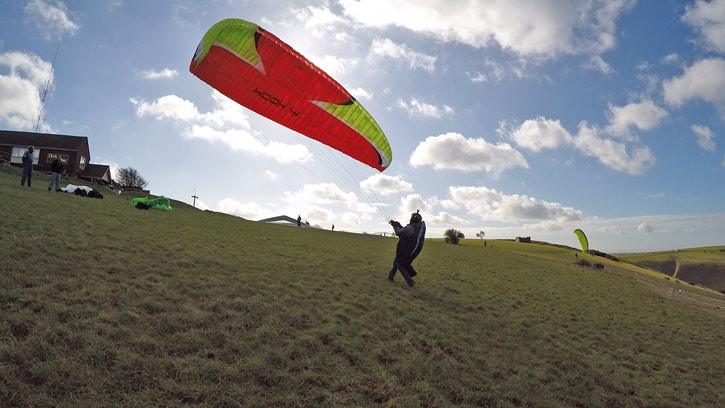
A slow, steady launch that is easy in strong winds
Carlo adds: The Hook 4 has a tendency to drop back if you don't bring it up all the way, but this can make a wing easier to launch because the wing doesn't overfly the pilot. For pilots who aren't quick enough to sense when the wing is coming up too fast and stop it before it overflies and collapses this sticking point in the launch can be a nice characteristic.
The lack of forward pitch saves pilots from being plucked, or having the wing overshoot and tuck, which can be really dangerous. But it limits the acceleration to achieve a short launch in tricky conditions. This puts the Hook 4 squarely in the Progression class: a wing suitable as a first buy wing, for pilots who maybe don't have the most coordinated reactions yet, and are likely to be launching from spacious sites.
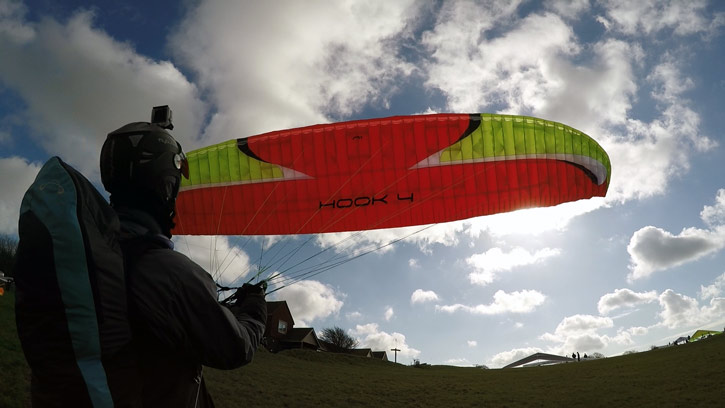
The wing drops back from this position and needs energizing on the As again
In the air the limited forward pitch is noticeable: it doesn't ever dive ahead of the pilot, and if pitch movements are induced on the brakes it will dampen out the surge very fast. On the yaw axis it stable enough. But strangely, it's quite loose in the roll axis - I found the wing rocking around in bumpy air. It didn't result in any change of direction so it's not unsafe, just more movement than I'm accustomed to in the class, with some freeplay in the centre of the wing. This can be useful in that it indicates which side to lean into to find more lift, but it might unsettle the nervous pilots.

Nice trailing edge and clean wing profile
The first part of the brake travel is soft and light, and although it initiates the beginning of a turn, this will flatten out after 90 degrees. It's necessary to bury the brake to get a good thermaling turn, at which point the brake pressure is moderate to high. Pushing too deeply on the brake produced a safe steady increase in bank angle and turn rate, leading slowly in to a spiral without any spin tendency. It takes its time to build up energy, and this is easily dampened on the turn exit. Unlike earlier Hook and Artik models, the turn does not require outside brake finesse to control the bank angle, so in this respect it's an improvement that will make thermaling easier for pilots who are still learning. The lack of energy means you get a steady turn of relatively fixed radius.
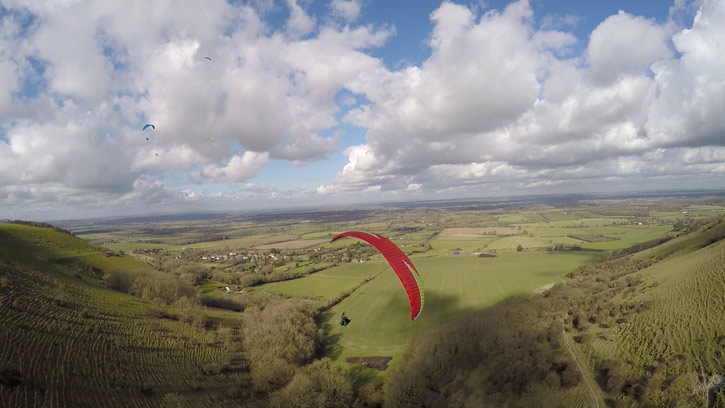
An easy moderate turn with a gentle feeling
For those who believe the rear risers are the best way to control pitching movements on speedbar, this is not the wing to use this technique on. It's seldom suitable on a three-liner, and definitely not on the Hook 4. Pulling the C's in flight bunches the wing up chordwise - far better to ride the speedbar to control what little pitch the Hook 4 will leave you.

Flying in close formation to get the shot!
The speedbar is easy to engage. Although my testing was based on approximate GPS speeds, it's not much more than a 10km/h increase from trim, meaning you're somewhere under 50km/h at top speed (loaded near the top, in standard conditions). It's adequate for the class. You might not win a race-to-goal into wind, but you won't be alarmed by an unstable wing - it felt completely benign at full bar; quite stable.
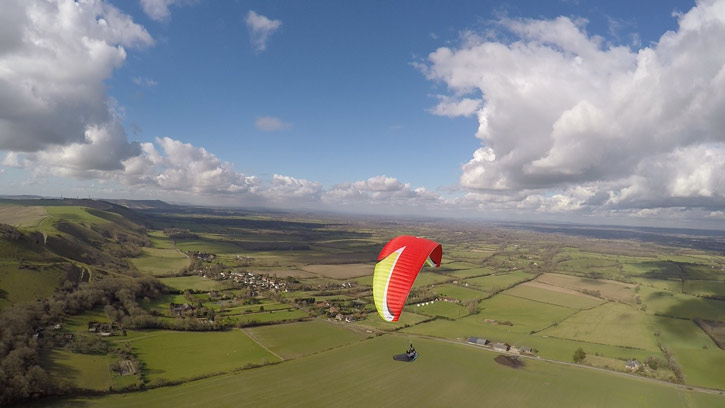
Competitive trim speed and speed range for the Progression Class
It seemed competitive in glide and climb rate. Big ears were stable and didn't noticeably affect the airspeed. They felt best with speedbar engaged. 50% asymmetric collapses produced hardly any turn and a very easy reinflation.

Playing around with gentle wingovers and spirals, it's clear that the wing doesn't generate much energy. This will help you when passing through turbulence, by reducing the added momentum of unwanted dives and rolls. If swooping and whooping is your idea of fun, you've probably outgrown the Progression class.

Roll is limited, for safety
Summary
The Hook 4 is an easy, accessible wing for flying school graduates and a safe introduction to thermal flying. The launch needs a continued pull, turns are simple and steady with light pressure (wide turns) or firm pressure (thermaling), and the passive safety is very reassuring. It has a calm character that supports pilot progression. In a word: mild.
Technical info
- HOOK 4 25 (80-100kg) flown at 84kg
- HARNESS USED: Skywalk Range XALPS
- TEST CONDITIONS: 2 hours in mild thermic conditions on a ridge, 12deg C, 1000ft up, with 25km/h basewind.
- TEST PILOT: instructor with over 2500 hours, over 150 wings reviewed, flying since 1992. Currently flying Omega XALPS.
More info on the Niviuk Hook 4 >
Niviuk Hook 4 paraglider review video

